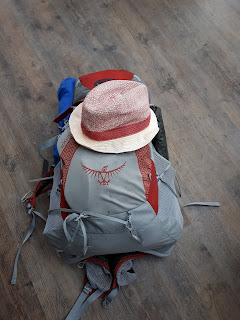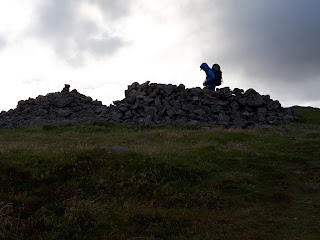I first visited there in 1996 with a group of hillwalkers.
For serious walkers this is a must do trip because there are three Munros (hills over 914m)
and three Corbetts (hills over 762m) in Knoydart. On
that first trip I climbed all three Munros and two Corbetts, deliberately leaving
one unclimbed because I wanted a reason to return.
When our friend, Ian, asked if Colin and I wanted
to help him climb the three Knoydart Corbetts I jumped at the chance. We are
both in training for another big trip. We left home on Tuesday evening and
drove to Crianlarich where our mountaineering club own a cottage. We grabbed a meal
in the nearby Ben More before belting back to the cottage in a torrential rain
storm. Next morning was clear and the roads quiet so we arrived in Mallaig in
plenty time for the 10.30am ferry. Unfortunately parking proved difficult in
this bustling town and we ended up sprinting for the boat. The training had
started early.
 |
| Inverie Pier |
The boat ride takes only 30 minutes but when the boat drops
you on the Inverie pier it feels like the end of the world.
Knoydart was part of a community buy out in 1999 and is managed
by the Knoydart Foundation. Inverie is a one street village with one pub, the
Foundation office and shop and a post office. As we walked the couple of
kilometres to the beach campsite I noticed Inverie seemed more prosperous than
the last time I visited. The Foundation is doing a good job
The campsite, on Long Beach, is basic with only a tap, a
composting toilet and a bothy type shed that holds all manner of emergency
supplies – the location is stunning with just enough sea breeze to keep midgies
at bay.
 |
| Camp Knoydart |
We quickly pitched our tents and headed up our first hill.
Sgurr Coire Choinnichean (796m) sits above Inverie, the normal route is from
just behind the pub but for some reason Ian’s planned route took us straight up
from the campsite. A steep slope covered with thick vegetation and neck high
bracken reminded me why I hate climbing Corbetts (most are without paths and
are often over rough ground). This one beat the lot. I uttered many expletives
on the ascent. I was miserable, especially due to the fact I’d climbed this
hill before by a better route. When we eventually joined a path the going got measurably
easier.
 |
| Coming out of the mist |
The summit is along a ridge which should have given us panorama views
of the surrounding area but sat in thick fog throughout our climb. We took the
main route back using a good path and were rewarded with good sea views as soon
as we dropped from the ridge.
 |
| Views at last |
The day had been warm and on the way down I fantasised about
a cold pint at the pub, but was disappointed to find it's closed on a Wednesday.
Thankfully the Foundation have built a wooden shed across from their shop,
which is also an off licence, and many people were enjoying a drink in the sun
by the shed. We soon joined in and sat on the beach sipping local ale while
trying to brush the deer ticks off our trousers. We cooked our camp food in the campsite bothy
and turned in before it was fully dark.
I got up early to meet the first boat. My friend Janette was
joining us and needed help with all her gear. We only hung around long enough
for Janette to pitch her tent before we all headed off for the second Corbett,
Beinn Bhuidhe (855m) and the hill I resisted climbing all those years ago. This
was our best weather day and we made full use of that by planning to climb the
full length of the 8km undulating ridge. We walked up the pleasant Gleann
Meadail and climbed on reasonable ground to the ridge.
 |
| On the Beinn Bhuidhe ridge look towards Eigg and Rum |
Looking east we could see
the cragginess of the Glendessary hills, and walking along the ridge into the
sun and towards the sea the views were of the islands of Eigg and Rum but on
closer inspection we found we could see as far west as the Outer Hebrides and
south as far as Jura. The ridge was spectacular, a route not to be missed. The descent
down to the campsite found us again on rough ground but somehow, at the end of
the walk, it didn’t seem so bad.
After a quick change we walked to the village. This time we
ate in the pub. The beer was good and the moules frites I had was delicious but
expensive for such a dish.
The wind picked up in the night and heavy gusts hammered the tents so
sleep was disturbed. Rain was forecast for our last walking day but it was the
wind causing the problem. Janette and I planned to climb the Munro Ladhar
Bheinn and Colin and Ian were going for their last Knoydart Corbett, Beinn na
Caillich (785m) so we all set off on the same track that led north west out of
the village. It rained on and off but the wind wasn’t letting up and I grew
concerned as we got nearer the hill. We stopped for a soggy lunch at a ruin
where our paths would part. Janette and I decided not to risk the Munro, the
wind was strong and gusting and we knew it would be impossible to reach the
summit. Colin and Ian kept going.
 |
| Red Deer grazing |
We were glad to get back to the village and have a coffee
and scone in the Pottery Café. Mhairi, Ian’s wife, came over on the afternoon
boat and we were all glad when the boys arrived back, battered but successful
despite having to crawl the last part to the summit.
Dinner was more camp food and an interesting chat in the
bothy with a London girl who was also camping.
A couple of the longer term campers lit a fire and many locals joined
them for a Friday night party. We were all too tired to join in so left them to
it. We had an early boat to catch.
The wind had died by morning and the midgies took full advantage
of that. Our tents were packed up through the veil of midge nets. We left
Knoydart in sunshine and I was envious of the visitors arriving off the boat we
were boarding.
It was glorious to get home to a hot bath and the chance to
remove the ticks I had picked up. The company was great and the hillwalking,
although tough, was satisfying.
I will definitely go back.
































